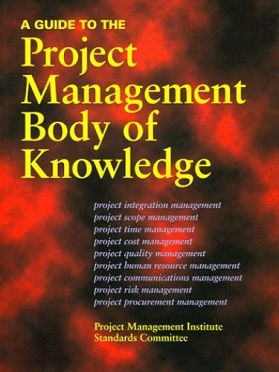Related Research Articles

In engineering and its various subdisciplines, acceptance testing is a test conducted to determine if the requirements of a specification or contract are met. It may involve chemical tests, physical tests, or performance tests.
Project management is the process of leading the work of a team to achieve all project goals within the given constraints. This information is usually described in project documentation, created at the beginning of the development process. The primary constraints are scope, time, and budget. The secondary challenge is to optimize the allocation of necessary inputs and apply them to meet pre-defined objectives.

The Project Management Body of Knowledge (PMBOK) is a set of standard terminology and guidelines for project management. The body of knowledge evolves over time and is presented in A Guide to the Project Management Body of Knowledge, a book whose seventh edition was released in 2021. This document results from work overseen by the Project Management Institute (PMI), which offers the CAPM and PMP certifications.
Agile software development is the mindset for developing software that derives from values agreed upon by The Agile Alliance, a group of 17 software practitioners in 2001. As documented in their Manifesto for Agile Software Development the practitioners value:
The Project Management Institute is a U.S.-based not-for-profit professional organization for project management.
Thoughtworks is a publicly-traded, global technology company with 49 offices in 18 countries. It provides software design and delivery, and tools and consulting services. The company is closely associated with the movement for agile software development, and has contributed to open source products. Thoughtworks' business includes Digital Product Development Services, Digital Experience and Distributed Agile software development.
Adaptive software development (ASD) is a software development process that grew out of the work by Jim Highsmith and Sam Bayer on rapid application development (RAD). It embodies the principle that continuous adaptation of the process to the work at hand is the normal state of affairs.
The incremental build model is a method of software development where the product is designed, implemented, and tested incrementally until the product is finished. It involves both development and maintenance. The product is defined as finished when it satisfies all of its requirements. This model combines the elements of the waterfall model with the iterative philosophy of prototyping. According to the Project Management Institute, an incremental approach is an "adaptive development approach in which the deliverable is produced successively, adding functionality until the deliverable contains the necessary and sufficient capability to be considered complete."

Scrum is an agile team collaboration framework commonly used in software development and other industries.

Agile Project Management: Creating Innovative Products by Jim Highsmith discusses the management of projects using the agile software development methodology. The book has been recommended by different reviewers.
James A. Highsmith III is an American software engineer and author of books in the field of software development methodology. He is the creator of Adaptive Software Development, described in his 1999 book "Adaptive Software Development", and winner of the 2000 Jolt Award, and the Stevens Award in 2005. Highsmith was one of the 17 original signatories of the Agile Manifesto, the founding document for agile software development.
Software Quality Management (SQM) is a management process that aims to develop and manage the quality of software in such a way so as to best ensure that the product meets the quality standards expected by the customer while also meeting any necessary regulatory and developer requirements, if any. Software quality managers require software to be tested before it is released to the market, and they do this using a cyclical process-based quality assessment in order to reveal and fix bugs before release. Their job is not only to ensure their software is in good shape for the consumer but also to encourage a culture of quality throughout the enterprise.
A glossary of terms relating to project management and consulting.
In software engineering, a software development process or software development life cycle (SDLC) is a process of planning and managing software development. It typically involves dividing software development work into smaller, parallel, or sequential steps or sub-processes to improve design and/or product management. The methodology may include the pre-definition of specific deliverables and artifacts that are created and completed by a project team to develop or maintain an application.
Lean project management is the application of lean concepts such as lean construction, lean manufacturing and lean thinking to project management.
Extreme project management (XPM) refers to a method of managing very complex and very uncertain projects.
The following outline is provided as an overview of and topical guide to project management:
eXtreme Manufacturing (XM) is an iterative and incremental framework for manufacturing improvement and new product development that was inspired by the software development methodology Scrum and the systematic waste-elimination (lean) production scheduling system Kanban(かんばん ).

Miguel "Mike" Beedle was an American software engineer and theoretical physicist who was a co-author of the Agile Manifesto.
References
- ↑ Denning, Steve (13 August 2016). "What Is Agile?" . Forbes. Retrieved 10 April 2020.
- ↑ Sanchez, Luis M.; Nagi, Rakesh (November 2010). "A Review of Agile Manufacturing Systems". ResearchGate. Retrieved 10 July 2022.
- ↑ Highsmith, Jim (1 January 2004). "Agile Project Management: Creating Innovative Products". The Agile Software Development Series. Retrieved 10 April 2020.
- ↑ ISO. "ISO 21502:2020: Project, programme and portfolio management — Guidance on project management". ISO. Retrieved 10 July 2022.
- ↑ PMI (2022). "PMBOK® Guide". PMBOK® Guide. Retrieved 10 July 2022.